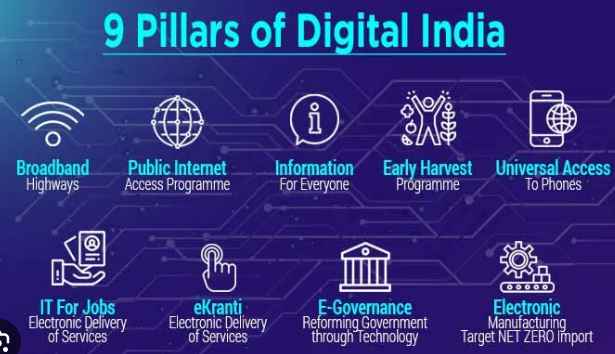Enhancing governance the digital way
Syllabus:
GS 2: e-governance
Why in the News?
Recently, India’s digital governance initiatives, including iGOT Karmayogi and e-office, have gained attention as transforming public service delivery, emphasizing the importance of digital skills, cybersecurity and capacity building.
Introduction
- India’s push for digital governance aims to enhance public service delivery and improve government efficiency.
- This shift requires equipping civil servants with the necessary digital skills.
- While initiatives like iGOT Karmayogi and e-office promote efficiency, challenges resistance to change, digital divide and cybersecurity risks must be addressed to ensure governance structure genuinely inclusive and effective.
Role of digital tools in governance
- Public service efficiencies
- Digital tools can streamline processes, reduce delays and increase transparency in government.
- Capacity Building
- Building the skills of civil servants is essential to fully harness the potential of these tools.
- The ability to effectively use digital platforms can ensure efficient service delivery.
- Historical Relevance -Chanakya views
- Chanakya’s principles of governance, especially from his treatise on economics– Arthashastra, continue to influence models of governance today.
- The book’s insights into state art, economic policy, and ethical leadership still permeate contemporary governance, providing a framework for political and business decisions.
- Training and education
- Continuous training programs for government employees are crucial to meet the challenges of digital governance.
- All stakeholders, from government agencies to community leaders, must have the tools and knowledge to embrace digital governance.
Key Initiatives to build digital capability
iGOT Karma Yogi Conference
- Launched in 2020, the online training platform provides government officials with essential skills in public administration, data analytics and digital technology.
- It provides a flexible learning curve, ensuring continuous improvement in skills.
- Adaptability is essential to succeed in a rapidly changing digital environment.
E-office functionality
- This system simplifies government administration, reduces paperwork and increases efficiency.
- It automates file management, improves complaint resolution processes, and improves real-time communication.
- Transparency and ease of operation are the main advantages of this system.
Government E-Marketplace (GeM)
- This online platform simplifies the buying process, reducing manual intervention.
- It promotes fairness, efficiency and accessibility in government procurement.
Importance of digital literacy
- The government is working hard to improve digital literacy among workers.
- Training programs focus on e-governance tools, cybersecurity and digital communication.
- Well-trained staff ensures quality service delivery and improved governance.
Challenges of digital governance
- Regardless of the initiatives, many challenges hinder the full realization of digital governance.
- Addressing these barriers is essential to ensure a smooth transition to a technology-driven system of government.
Resistance to change
- Some employees are hesitant to adopt new technologies due to lack of familiarity.
- Bureaucratic processes can lead to slow change, resulting in uneven digital adoption.
- Training and additional resources can help those struggling with change.
Need for meaningful incentives
- Platforms like iGOT Karmayogi risk becoming just attendance monitors if they don’t translate into real business benefits.
- Success should be measured by how well employees use new skills, not just the number of participants.
- Linking training to performance improvements and actual applications can enhance its impact.
Bridge digital divide
- High-speed internet and limited access to digital devices is a major challenge in rural areas.
- If this gap is not addressed, many workers and citizens are at risk of being left out of the digital transformation.
- Strengthening digital infrastructure in underserved areas is essential for inclusive governance.
Cybersecurity problems
- As government operations move online, the risk of cyber threats increases.
- Protecting sensitive data is essential to maintaining trust in digital governance.
- Training employees in cybersecurity practices can help protect government systems.
Continuous learning and change
- With the rapid advancement of digital technologies, employees must remain innovative.
- Regular programs for employees ensure that employees remain productive and confident.
- Capacity building strategies must be dynamic and adapt to emerging trends.
Way forward for digital governance
- India has made great strides in digital governance, but more efforts are needed to unleash its full potential.
- Ensuring that all employees can use digital tools effectively is key to creating an efficient and effective governance system.
Strengthening infrastructure
- Good governance requires strong digital infrastructure.
- Expansion of high-speed internet, especially in rural areas, will bridge the digital divide.
Targeted training for employees
- Training programs should focus on practical application, not just participation.
- Employees at all levels need access to learning opportunities to stay updated.
Building a dynamic workforce
- A digitally literate workforce can improve governance performance.
- It will help employees embrace change by encouraging innovation and flexibility.
Conclusion
India’s digital governance transformation is promising, but success depends on overcoming skills gaps, overcoming resistance and ensuring cybersecurity. By empowering every civil servant, India can build a transparent, efficient and citizen-centric governance system for the future.
Source: The Hindu
Mains Practice Question:
Discuss the importance of intiatives like iGOT Karmayogi in developing digitally competent civil servants. Evaluate their impact and identify steps to ensure meaningful outcomes beyond participation estimates.




